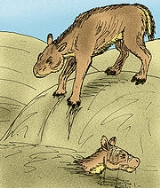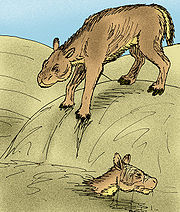
Leptauchenia
Encyclopedia
Leptauchenia is an extinct goat
-like genus
of terrestrial
herbivore
belonging to the oreodont
family
Merycoidodontidae, and the type genus of the tribe
Leptaucheniini. The genus was endemic to North America
during the Late Oligocene (33.9—16.3 mya) and lived for approximately .
 Because the eyes and nostrils were placed high on the head, it was long assumed that Leptauchenia was an aquatic, or semi-aquatic animal. However, because their fossils have never been found in floodplain deposits or river channels, and their abundance in fossil sand dunes, Donald Prothero suggests that they were desert-dwelling animals. According to Prothero's interpretation, the high-placed eyes and nostrils served to filter out sand while burrowing.
Because the eyes and nostrils were placed high on the head, it was long assumed that Leptauchenia was an aquatic, or semi-aquatic animal. However, because their fossils have never been found in floodplain deposits or river channels, and their abundance in fossil sand dunes, Donald Prothero suggests that they were desert-dwelling animals. According to Prothero's interpretation, the high-placed eyes and nostrils served to filter out sand while burrowing.
A single specimen was examined by M. Mendoza for body mass and estimated to have a weight of 39.3 kilogram.
, it is often quoted as being the most numerous mammal in North America during the Late Oligocene. It had high-crowned, hypsodont teeth which were used to chew gritty vegetation.
Goat
The domestic goat is a subspecies of goat domesticated from the wild goat of southwest Asia and Eastern Europe. The goat is a member of the Bovidae family and is closely related to the sheep as both are in the goat-antelope subfamily Caprinae. There are over three hundred distinct breeds of...
-like genus
Genus
In biology, a genus is a low-level taxonomic rank used in the biological classification of living and fossil organisms, which is an example of definition by genus and differentia...
of terrestrial
Terrestrial animal
Terrestrial animals are animals that live predominantly or entirely on land , as compared with aquatic animals, which live predominantly or entirely in the water , or amphibians, which rely on a combination of aquatic and terrestrial habitats...
herbivore
Herbivore
Herbivores are organisms that are anatomically and physiologically adapted to eat plant-based foods. Herbivory is a form of consumption in which an organism principally eats autotrophs such as plants, algae and photosynthesizing bacteria. More generally, organisms that feed on autotrophs in...
belonging to the oreodont
Oreodont
Oreodons, sometimes called prehistoric "ruminating hogs," were a family of cud-chewing plant-eater with a short face and tusk-like canine teeth...
family
Family (biology)
In biological classification, family is* a taxonomic rank. Other well-known ranks are life, domain, kingdom, phylum, class, order, genus, and species, with family fitting between order and genus. As for the other well-known ranks, there is the option of an immediately lower rank, indicated by the...
Merycoidodontidae, and the type genus of the tribe
Tribe (biology)
In biology, a tribe is a taxonomic rank between family and genus. It is sometimes subdivided into subtribes.Some examples include the tribes: Canini, Acalypheae, Hominini, Bombini, and Antidesmeae.-See also:* Biological classification* Rank...
Leptaucheniini. The genus was endemic to North America
North America
North America is a continent wholly within the Northern Hemisphere and almost wholly within the Western Hemisphere. It is also considered a northern subcontinent of the Americas...
during the Late Oligocene (33.9—16.3 mya) and lived for approximately .
Morphology

A single specimen was examined by M. Mendoza for body mass and estimated to have a weight of 39.3 kilogram.
Fossil distribution
Skeletons of Leptauchenia have been found by the thousands and in greater numbers than the related genus SespiaSespia
Sespia is an extinct genus of terrestrial herbivore of the family Merycoidodontidae, subfamily Merycoidodontinae , endemic to North America during the Whitneyan stage of the Oligocene-Late Oligocene epochs existing for approximately .-Taxonomy:Sespia was named by Schultz and Falkenbach as a...
, it is often quoted as being the most numerous mammal in North America during the Late Oligocene. It had high-crowned, hypsodont teeth which were used to chew gritty vegetation.
Species
- L. brevifacies (syn. Pithecistes decedens)
- L. decora (type species) (syn. Hadroleptauchenia primitiva, Leptauchenia harveyi, Pithecistes breviceps, Pithecistes facies, Pithecistes tanneri, Pseudocyclopidius frankforteri)
- L. eiselyi
- L. major (syn. Brachymeryx feliceps, Cyclopidius emydinus, Cyclopidius incisivus, Cyclopidius lullianus, Cyclopidius simus, Hadroleptauchenia extrema, Hadroleptauchenia shanafeltae, L. densa, L. margeryae, L. martini, L. parasimus, Pithecistes altageringensis, Pithecistes copei)
- L. orellaensis

